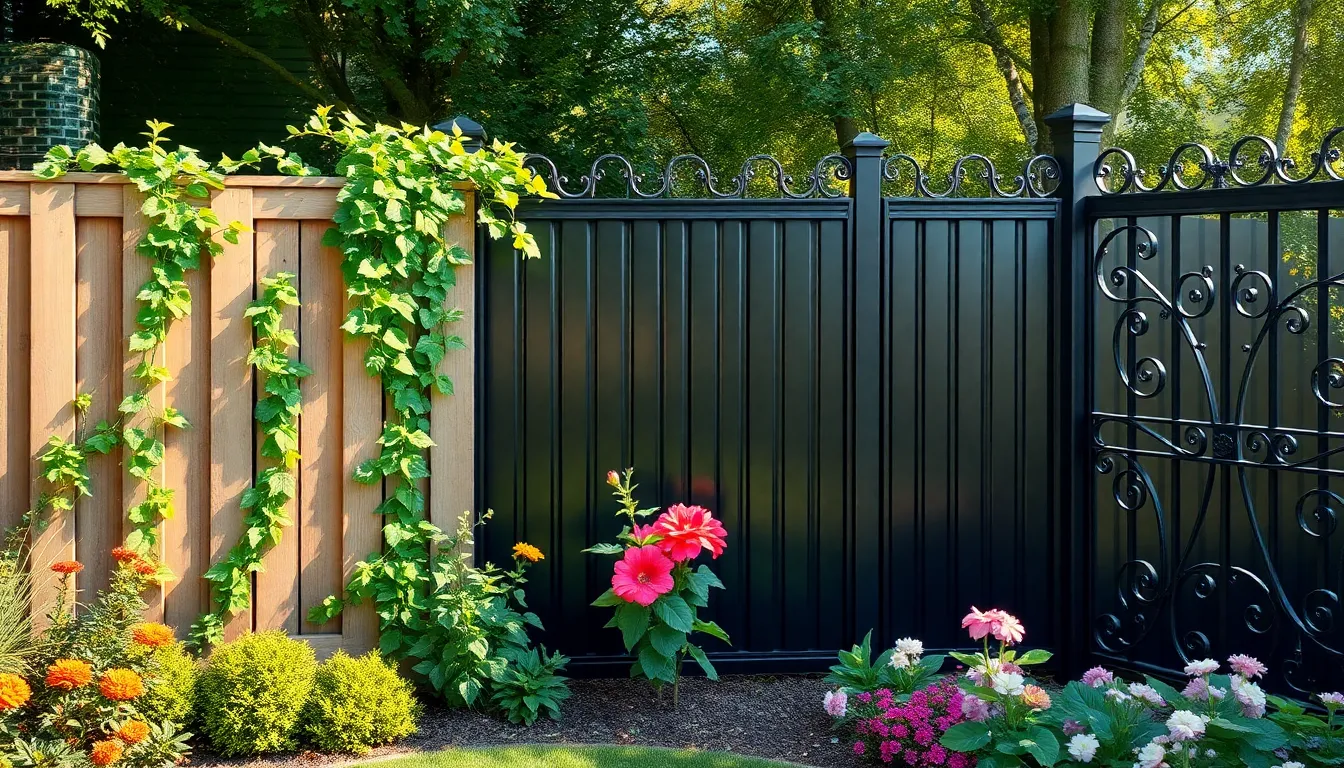Every garden needs a good fence, and not just to keep the nosy neighbor’s cat from using it as a litter box. A well-chosen garden fence can elevate your outdoor space, providing security, style, and a sense of privacy. Imagine enjoying your morning coffee without an audience of curious squirrels or overly friendly passersby.
Table of Contents
ToggleOverview of Garden Fencing
Garden fencing plays a crucial role in defining and protecting outdoor spaces. Various types of fences exist, including wooden, vinyl, and metal options. Each material has unique benefits, such as durability or aesthetic appeal.
Security features prominently among the benefits of garden fencing. It deters unwanted animals from entering the garden and keeps pets contained. When strategically placed, fences enhance privacy, allowing individuals to enjoy their garden without interruptions from neighbors.
Style in garden fencing contributes significantly to outdoor aesthetics. A well-chosen fence can complement the architecture of a home while adding a decorative touch. Decorative elements, like lattice or post caps, create visual interest that enhances overall landscapes.
Consideration of cost is critical when selecting a garden fence. Prices vary based on materials, design complexity, and height requirements. Budget constraints typically influence the selection of fence types.
Maintenance requirements differ across materials. Wooden fences may need annual staining or sealing, while vinyl options often only require occasional cleaning. Regular upkeep ensures longevity and preserves the appearance of the fence.
Legal aspects also come into play when installing garden fencing. Local zoning laws often dictate property boundaries and height restrictions. Checking regulations before installation helps prevent future disputes with neighbors.
Ultimately, garden fencing serves multiple purposes, from security to beautification. Choosing the right style depends on individual preferences and specific needs. Understanding the various aspects of garden fencing can guide homeowners toward making informed decisions for their outdoor spaces.
Types of Garden Fencing

Understanding the types of garden fencing allows homeowners to make informed choices. Each type offers unique advantages, catering to various aesthetic and functional needs.
Wooden Fencing
Wooden fencing provides a classic look for gardens and comes in multiple styles, such as picket and privacy. This type offers natural beauty while adding warmth to outdoor spaces. Durability depends on the wood used; pressure-treated options resist decay better than untreated wood. Maintenance includes annual sealing or painting to preserve appearance and functionality. Cost-effective solutions are available, but longevity hinges on proper care. Consider local availability when selecting wood types, as certain species perform better in specific climates.
Vinyl Fencing
Vinyl fencing stands out due to its low maintenance requirements and long lifespan. This type resists fading, cracking, and peeling, making it an attractive option for homeowners seeking durability. Variety in styles and colors enables customization to complement any garden décor. Initial costs might be higher than wood, but savings emerge in reduced upkeep over time. Environmental impact remains a consideration, as production processes differ across manufacturers. Vinyl’s ease of installation allows for quick setup, enhancing the garden’s appeal almost immediately.
Metal Fencing
Metal fencing is synonymous with strength and security, often used for both decorative and protective purposes. Options include aluminum, wrought iron, and chain link, each with distinctive visual characteristics and durability levels. Aluminum and wrought iron offer a more elegant appearance, enhancing architectural style. Chain link provides practicality, especially for keeping pets safe within the property. Corrosion resistance varies by material, influencing long-term performance and upkeep. Pricing fluctuates depending on material choice and design intricacies.
Benefits of Garden Fencing
Garden fencing offers numerous advantages that enhance both functionality and appearance. Three primary benefits include security, privacy, and aesthetic appeal.
Security and Privacy
Security serves as a crucial reason for installing garden fencing. It creates a barrier that deters unwanted animals and keeps pets safely contained. In addition, higher fences limit visibility from passersby, enhancing privacy for outdoor activities. Homeowners can enjoy their gardens without interruptions from neighbors or wildlife. Not only does a solid fence provide peace of mind, but it also acts as a protective shield for flowers and vegetables. The combination of safety and seclusion fosters a more enjoyable outdoor experience.
Aesthetic Appeal
Aesthetic appeal significantly influences the choice of garden fencing. Various materials, such as wood, vinyl, and metal, come in styles that complement home architecture. Beautifully crafted fences enhance the landscape, providing structure and charm to outdoor spaces. Vibrant colors and design elements can transform an ordinary garden into an inviting retreat. Decorative features, like latticework or trellises, add visual interest. A well-designed fence not only serves practical purposes but also contributes to overall home value, making it a worthy investment.
Factors to Consider When Choosing Garden Fencing
Selecting the right garden fencing involves several key factors that ensure both practicality and aesthetics.
Material Durability
Material durability significantly impacts the longevity of garden fencing. Wooden options require regular maintenance and vary in lifespan based on wood type. Hardwoods like cedar resist rot better than softwoods but still need yearly upkeep. Vinyl tends to outperform, offering resistance to fading and warping while lasting up to 30 years. Metal fencing, such as aluminum or wrought iron, excels in durability and security. Each material presents unique characteristics, so understanding these variations aids in making a solid choice.
Cost and Budget
Cost considerations play a vital role in the decision-making process for garden fencing. Prices fluctuate widely based on material type, design complexity, and height requirements. Wooden fences typically offer a budget-friendly option, while vinyl installations may require a larger initial investment. Metal fences often balance durability with a moderate price range. To manage spending, homeowners should define their budget early in the planning stages and explore various quotes from suppliers. This careful planning ensures a suitable option that aligns with financial constraints.
Installation Requirements
Installation requirements can vary based on the type of fence chosen. Wooden fences often necessitate a concrete foundation for stability and may require time-consuming assembly. Vinyl fences, though easier to install, still demand careful measuring and alignment. Metal fencing generally involves specific tools and professional assistance, especially for heavier materials. Checking local regulations and ensuring compliance with zoning laws is essential, as failing to do so could result in complications. Homeowners should also consider pre-assembly options or hire professionals to streamline the installation process.
A well-chosen garden fence significantly elevates any outdoor space. It not only enhances security and privacy but also adds a touch of style that complements the home. By considering various materials and their unique benefits, homeowners can find the perfect fence that meets both aesthetic desires and functional needs.
Investing in quality garden fencing is a decision that pays off in the long run. It protects plants and pets while creating a serene environment free from distractions. With careful planning and consideration of local regulations, anyone can transform their garden into a private oasis.


